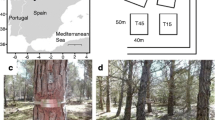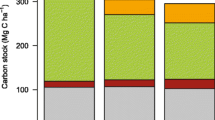Abstract
Hydrology-oriented silviculture might adapt Mediterranean forests to climatic changes, although its implementation demands a better understanding and quantification on the water fluxes. The influence of thinning intensity (high, medium, low and a control) and its effect on the mid-term (thinned plots in 1998 and 2008) on the water cycle (transpiration, soil water and interception) and growth [basal area increment (BAI)] were investigated in 55-year-old Aleppo pine trees. Thinning enhanced a lower dependence of growth on climate fluctuations. The high-intensity treatment showed significant increases in the mean annual BAI (from 4.1 to 17.3 cm2) that was maintained in the mid-term. Thinning intensity progressively increased the sap flow velocity (v s) in all cases with respect to the control. In the mid-term, an increased functionality of the inner sapwood was also observed. Mean daily tree water use ranged from 5 (control) to 18 (high intensity) l tree−1. However, when expressed on an area basis, daily transpiration ranged from 0.18 (medium) to 0.30 mm (control), meaning that in spite of the higher transpiration rates in the remaining trees, stand transpiration was reduced with thinning. Deep infiltration of water was also enhanced with thinning (about 30 % of rainfall) and did not compete with transpiration, as both presented opposite seasonal patterns. The changes in the stand water relationships after 10 years were well explained by the forest cover metric. The blue to green water ratio changed from 0.15 in the control to 0.72 in the high-intensity treatment, with the remaining treatments in the 0.34–0.48 range.






Similar content being viewed by others
References
Andréassian V (2004) Waters and forests: from historical controversy to scientific debate. J Hydrol 291:1–27. doi:10.1016/j.jhydrol.2003.12.015
Aussenac G (2000) Interactions between forest stands and microclimate: ecophysiological aspects and consequences for silviculture. Ann For Sci 57:287–301
Aussenac G, Granier A (1988) Effects of thinning on water stress and growth in Douglas-fir. Can J For Res 18:100–105. doi:10.1139/x88-015
Belmonte Serrato F (1997) Interceptación en bosque y matorral mediterráneo semiárido: Balance hídrico y distribución espacial de la lluvia neta. Doctoral Thesis, Universidad de Murcia
Birot Y, Gracia C (2011) The hydrologic cycle at a glance: blue and green water. In: Birot Y, Gracia C, Palahi M (eds) Water for forests and people in the mediterranean region: a challenging balance. European Forest Institute, Joensuu, pp 17–21
Bunn AG (2008) A dendrochronology program library in R (dplR). Dendrochronologia 26:115–124. doi:10.1016/j.dendro.2008.01.002
Burgess SSO, Adams MA, Turner NC, Beverly CR, Ong CK, Khan AAH, Bleby TM (2001) An improved heat pulse method to measure low and reverse rates of sap flow in woody plants. Tree Physiol 21:589–598. doi:10.1093/treephys/21.9.589
Cohen Y, Cohen S, Cantuarias-Aviles T, Schiller G (2008) Variations in the radial gradient of sap velocity in trunks of forest and fruit trees. Plant Soil 305:49–59. doi:10.1007/s11104-007-9351-0
Condés S, Sterba H (2008) Comparing an individual tree growth model for Pinus halepensis Mill. in the Spanish region of Murcia with yield tables gained from the same area. Eur J For Res 127:253–261. doi:10.1007/s10342-007-0201-7
Cook ER, Briffa KR (1990) A comparison of some tree-ring standardization methods. In: Cook ER, Kairiukstis LA (eds) Methods of dendrochronology: applications in the environmental science. Springer, Kluwer, pp 104–123
Core Team R (2013) R: a language and environment for statistical computing. R Foundation for Statistical Computing, Vienna
De Luis M, Novak K, Čufar K, Raventós J (2009) Size mediated climate–growth relationships in Pinus halepensis and Pinus pinea. Trees 23:1065–1073. doi:10.1007/s00468-009-0349-5
Del Campo AD (2013) Research resource review: revisiting experimental catchment studies in forest hydrology: proceedings of a workshop held during the XXV IUGG General Assembly in Melbourne, Australia. Prog Phys Geogr 37:147–149. doi:10.1177/0309133312465252
Delzon S, Loustau D (2005) Age-related decline in stand water use: sap flow and transpiration in a pine forest chronosequence. Agric For Meteorol 129:105–119. doi:10.1016/j.agrformet.2005.01.002
Delzon S, Sartore M, Granier A, Loustau D (2004) Radial profiles of sap flow with increasing tree size in maritime pine. Tree Physiol 24:1285–1293. doi:10.1093/treephys/24.11.1285
Devitt DA, Smith SD (2002) Root channel macropores enhance downward movement of water in a Mojave Desert ecosystem. J Arid Environ 50:99–108. doi:10.1006/jare.2001.0853
Falkenmark M (2003) Freshwater as shared between society and ecosystems: from divided approaches to integrated challenges. Philos Trans R Soc B 358:2037–2049
FAO (2010) Global forest resources assessment 2010: main report. Food and Agriculture Organization of the United Nations, Rome
Fitzgerald J, Jacobsen JB, Blennow K, Thorsen BJ, Lindner M (2013) Climate change in European forests: how to adapt. European Forest Institute, Joensuu
Fritts H (1976) Tree rings and climate. Elsevier Science, London
Ganatsios HP, Tsioras PA, Pavlidis T (2010) Water yield changes as a result of silvicultural treatments in an oak ecosystem. For Ecol Manag 260:1367–1374. doi:10.1016/j.foreco.2010.07.033
Giuggiola A, Bugmann H, Zingg A, Dobbertin M, Rigling A (2013) Reduction of stand density increases drought resistance in xeric Scots pine forests. For Ecol Manag 310:827–835. doi:10.1016/j.foreco.2013.09.030
Granier A (1987) Evaluation of transpiration in a Douglas-fir stand by means of sap flow measurements. Tree Physiol 3:309–320. doi:10.1093/treephys/3.4.309
Hatton TJ, Catchpole EA, Vertessy RA (1990) Integration of sapflow velocity to estimate plant water use. Tree Physiol 6:201–209. doi:10.1093/treephys/6.2.201
Hernandez-Santana V, Asbjornsen H, Sauer T, Isenhart T, Schilling K, Schultz R (2011) Enhanced transpiration by riparian buffer trees in response to advection in a humid temperature agricultural landscape. For Ecol Manag 261:1415–1427. doi:10.1016/j.foreco.2011.01.027
Holmes RL (1983) Computer-assisted quality control in tree-ring dating and measurement. Tree Ring Bull 43:51–67
Klein T, Shpringer I, Fikler B, Elbaz G, Cohen S, Yakir D (2013) Relationships between stomatal regulation, water-use, and water-use efficiency of two coexisting key Mediterranean tree species. For Ecol Manag 302:34–42. doi:10.1016/j.foreco.2013.03.044
Linares JC, Delgado-Huertas A, Carreira JA (2011) Climatic trends and different drought adaptive capacity and vulnerability in a mixed Abies pinsapo–Pinus halepensis forest. Clim Change 105:67–90. doi:10.1007/s10584-010-9878-6
Lindner M, Maroschek M, Netherer S, Kremer A, Barbati A, Garcia-Gonzalo J, Seidi R, Delzon S, Corona P, Kolström M, Lexer MJ, Marchetti M (2010) Climate change impacts, adaptive capacity, and vulnerability of European forest ecosystems. For Ecol Manag 259:698–709. doi:10.1016/j.foreco.2009.09.023
Maestre F, Cortina J (2004) Are Pinus halepensis plantations useful as a restoration tool in semiarid Mediterranean areas? For Ecol Manag 198:303–317
Major J (1951) A functional, factorial approach to plant ecology. Ecology 32:392–412. doi:10.2307/1931718
Martínez-Vilalta J, Piñol J, Beven K (2002) A hydraulic model to predict drought-induced mortality in woody plants: an application to climate change in the Mediterranean. Ecol Model 155:127–147. doi:10.1016/S0304-3800(02)00025-X
Medhurst JL, Battaglia M, Beadle CL (2002) Measured and predicted changes in tree and stand water use following high-intensity thinning of an 8-year-old Eucalyptus nitens plantation. Tree Physiol 22:775–784. doi:10.1093/treephys/22.11.775
Meko D, Stockton CW, Boggess WR (1995) The tree-ring record of severe sustained drought. J Am Water Resour Assoc 31:789–801. doi:10.1111/j.1752-1688.1995.tb03401.x
Mérian P, Pierrat J-C, Lebourgeois F (2013) Effect of sampling effort on the regional chronology statistics and climate–growth relationships estimation. Dendrochronologia 31:58–67. doi:10.1016/j.dendro.2012.07.001
Molina AJ, del Campo AD (2012) The effects of experimental thinning on throughfall and stemflow: a contribution towards hydrology-oriented silviculture in Aleppo pine plantations. For Ecol Manag 269:206–213. doi:10.1016/j.foreco.2011.12.037
Montero G, Cañellas I, Ruíz-Peinado R (2001) Growth and yield models for Pinus halepensis Mill. Rev Investig Agrar Sist Recur For 10:179–201
Morikawa Y, Hattori S, Kiyono Y (1986) Transpiration of a 31-year-old Chamaecyparis obtusa Endl. stand before and after thinning. Tree Physiol 2:105–114. doi:10.1093/treephys/2.1-2-3.105
O’Grady AP, Eamus D, Hutley LB (1999) Transpiration increases during the dry season: patterns of tree water use in eucalypt open-forests of northern Australia. Tree Physiol 19:591–597. doi:10.1093/treephys/19.9.591
Pereira FL, Gash JHC, David JS, Valente F (2009) Evaporation of intercepted rainfall from isolated evergreen oak trees: do the crowns behave as wet bulbs? Agric For Meteorol 149:667–679. doi:10.1016/j.agrformet.2008.10.013
Persson HA (2012) The high input of soil organic matter from dead tree fine roots into the forest soil. Int J For Res 2012:1–9. doi:10.1155/2012/217402
Planchon O, Dubreuil V, Bernard V, Blain S (2008) Contribution of tree-ring analysis to the study of droughts in northwestern France (XIX–XXth century). Clim Past Discuss 4:249–270
Raventós J, De Luís M, Gras MJ, Cufar K, Gonzalez-Hidalgo JC, Bonet A, Sanchez JR (2001) Growth of Pinus pinea and Pinus halepensis as affected by dryness, marine spray and land use changes in a Mediterranean semiarid ecosystem. Dendrochronologia 19:211–220
Rutter AJ (1963) Studies in the water relations of Pinus Sylvestris in plantation conditions I. Measurements of rainfall and interception. J Ecol 51:191–203. doi:10.2307/2257513
Sánchez-Salguero R, Navarro RM, Camarero JJ, Fernández-Cancio Á (2010) Drought-induced growth decline of Aleppo and maritime pine forests in south-eastern Spain. For Syst 19:458–470
Sarris D, Christodoulakis D, Körner C (2007) Recent decline in precipitation and tree growth in the eastern Mediterranean. Glob Change Biol 13:1187–1200. doi:10.1111/j.1365-2486.2007.01348.x
Sarris D, Christodoulakis D, Körner C (2011) Impact of recent climatic change on growth of low elevation eastern Mediterranean forest trees. Clim Change 106:203–223. doi:10.1007/s10584-010-9901-y
Schiller G, Cohen Y (1998) Water balance of Pinus halepensis Mill. afforestation in an arid region. For Ecol Manag 105:121–128. doi:10.1016/S0378-1127(97)00283-1
Shelburne VB, Hedden RL (1996) Effect of stem height, dominance class, and site quality on sapwood permeability in loblolly pine, (Pinus taeda L.). For Ecol Manag 83:163–169. doi:10.1016/0378-1127(96)03727-9
Steel RGD, Torrie JH (1989) Bioestadística: principios y procedimientos. McGraw-Hill, New York
Ungar ED, Rotenberg E, Raz-Yaseef N, Cohen S, Yakir D, Schiller G (2013) Transpiration and annual water balance of Aleppo pine in a semiarid region: implications for forest management. For Ecol Manag 298:39–51. doi:10.1016/j.foreco.2013.03.003
Webb AA, Bonell M, Bre L, Lane PNJ, McGuire D, Neary DG, Nettles J, Scott DF, Stednick JD, Wang Y (eds) (2012) Revisiting experimental catchment studies in forest hydrology. Proceedings of a workshop held during the XXV IUGG General Assembly in Melbourne, Australia, June-July 2011, vol 353. IAHS Publication, Wallingford
White D, Beadle C, Worledge D, Honeysett J, Cherry M (1998) The influence of drought on the relationship between leaf and conducting sapwood area in Eucalyptus globulus and Eucalyptus nitens. Trees 12:406–414. doi:10.1007/PL00009724
Williams DG, Cable W, Hultine K, Hoedjes JCB, Yepez EA, Simonneaux V, Er-Raki S, Boulet G, Bruin HAR, Chehbouni A, Hartogensis OK, Timouk F (2004) Evapotranspiration components determined by stable isotopes, sap flow and eddy covariance techniques. Agric For Meteorol 125:241–258. doi:10.1016/j.agroformet.2004.04.008
Acknowledgments
This study is a component of two research projects: “CGL2011-28776-C02-02, Hydrological characterisation of forest structures at plot scale for an adaptive management, HYDROSIL”, funded by the Spanish Ministry of Science and Innovation and FEDER funds, and “Determination of hydrological and forest recovery factors in Mediterranean forests and their social perception”, led by Dr. E. Rojas and supported by the Ministry of Environment, Rural and Marine Affairs. The authors are grateful to the Valencia Regional Government (CMAAUV, Generalitat Valenciana) and the VAERSA staff for their support in allowing the use of the La Hunde experimental forest and for their assistance in carrying out the fieldwork. The second author thanks the Mundus 17 Program, coordinated by the University of Porto—Portugal.
Author information
Authors and Affiliations
Corresponding author
Additional information
Communicated by R. Matyssek.
Electronic supplementary material
Below is the link to the electronic supplementary material.
10342_2014_805_MOESM1_ESM.pdf
Supplementary material Fig. 1 Mean and standard deviation values of tree stemflow (l) and rainfall (mm) in the different spells studied for this variable. (PDF 35 kb)
10342_2014_805_MOESM2_ESM.pdf
Supplementary material Fig. 2 Mean daily values of sap flow velocity (cm h-1) as a function of the mean daily values of VPD (KPa) for each treatment (PDF 85 kb)
10342_2014_805_MOESM3_ESM.pdf
Supplementary material Fig. 3 Relationship between the blue to green water ratio (B/G) and forest cover (proportion). N= 5. The model was statistically significant at p-value<0.01. (PDF 37 kb)
Rights and permissions
About this article
Cite this article
del Campo, A.D., Fernandes, T.J.G. & Molina, A.J. Hydrology-oriented (adaptive) silviculture in a semiarid pine plantation: How much can be modified the water cycle through forest management?. Eur J Forest Res 133, 879–894 (2014). https://doi.org/10.1007/s10342-014-0805-7
Received:
Revised:
Accepted:
Published:
Issue Date:
DOI: https://doi.org/10.1007/s10342-014-0805-7




